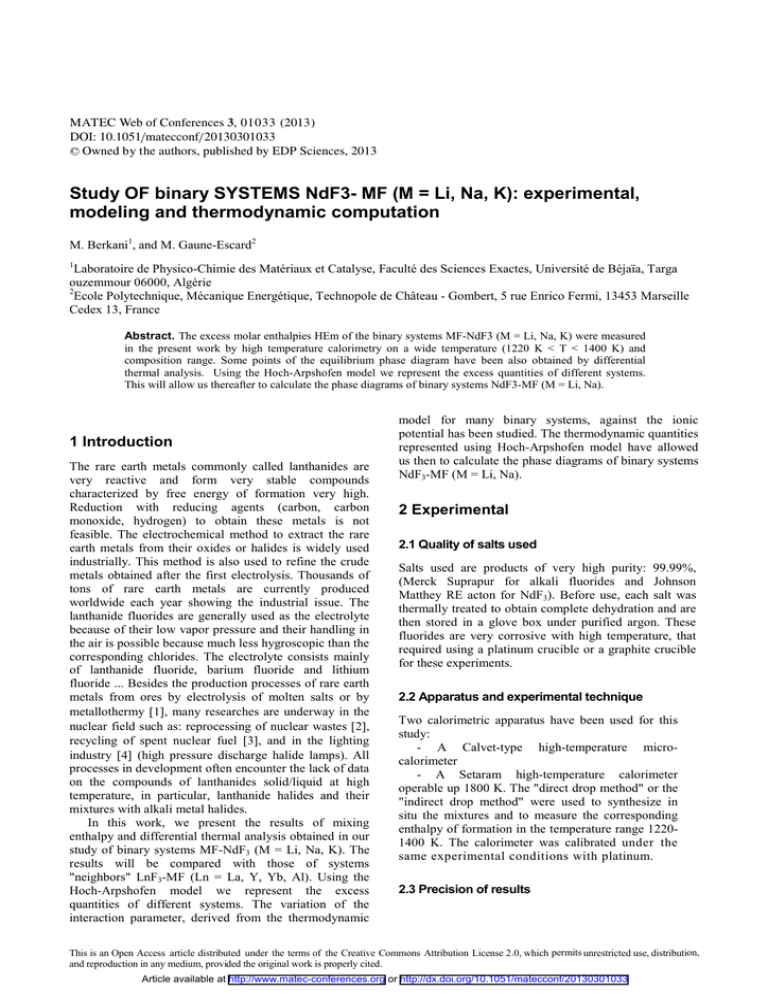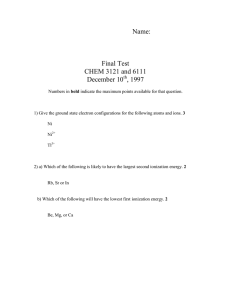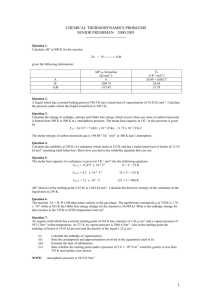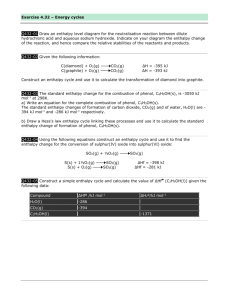Study OF binary SYSTEMS NdF3- MF (M = Li, Na,... modeling and thermodynamic computation
advertisement

MATEC Web of Conferences 3, 01033 (2013) DOI: 10.1051/matecconf/20130301033 C Owned by the authors, published by EDP Sciences, 2013 Study OF binary SYSTEMS NdF3- MF (M = Li, Na, K): experimental, modeling and thermodynamic computation M. Berkani1, and M. Gaune-Escard2 1 Laboratoire de Physico-Chimie des Matériaux et Catalyse, Faculté des Sciences Exactes, Université de Béjaïa, Targa ouzemmour 06000, Algérie 2 Ecole Polytechnique, Mécanique Energétique, Technopole de Château - Gombert, 5 rue Enrico Fermi, 13453 Marseille Cedex 13, France Abstract. The excess molar enthalpies HEm of the binary systems MF-NdF3 (M = Li, Na, K) were measured in the present work by high temperature calorimetry on a wide temperature (1220 K < T < 1400 K) and composition range. Some points of the equilibrium phase diagram have been also obtained by differential thermal analysis. Using the Hoch-Arpshofen model we represent the excess quantities of different systems. This will allow us thereafter to calculate the phase diagrams of binary systems NdF3-MF (M = Li, Na). 1 Introduction The rare earth metals commonly called lanthanides are very reactive and form very stable compounds characterized by free energy of formation very high. Reduction with reducing agents (carbon, carbon monoxide, hydrogen) to obtain these metals is not feasible. The electrochemical method to extract the rare earth metals from their oxides or halides is widely used industrially. This method is also used to refine the crude metals obtained after the first electrolysis. Thousands of tons of rare earth metals are currently produced worldwide each year showing the industrial issue. The lanthanide fluorides are generally used as the electrolyte because of their low vapor pressure and their handling in the air is possible because much less hygroscopic than the corresponding chlorides. The electrolyte consists mainly of lanthanide fluoride, barium fluoride and lithium fluoride ... Besides the production processes of rare earth metals from ores by electrolysis of molten salts or by metallothermy [1], many researches are underway in the nuclear field such as: reprocessing of nuclear wastes [2], recycling of spent nuclear fuel [3], and in the lighting industry [4] (high pressure discharge halide lamps). All processes in development often encounter the lack of data on the compounds of lanthanides solid/liquid at high temperature, in particular, lanthanide halides and their mixtures with alkali metal halides. In this work, we present the results of mixing enthalpy and differential thermal analysis obtained in our study of binary systems MF-NdF3 (M = Li, Na, K). The results will be compared with those of systems "neighbors" LnF3-MF (Ln = La, Y, Yb, Al). Using the Hoch-Arpshofen model we represent the excess quantities of different systems. The variation of the interaction parameter, derived from the thermodynamic model for many binary systems, against the ionic potential has been studied. The thermodynamic quantities represented using Hoch-Arpshofen model have allowed us then to calculate the phase diagrams of binary systems NdF3-MF (M = Li, Na). 2 Experimental 2.1 Quality of salts used Salts used are products of very high purity: 99.99%, (Merck Suprapur for alkali fluorides and Johnson Matthey RE acton for NdF3). Before use, each salt was thermally treated to obtain complete dehydration and are then stored in a glove box under purified argon. These fluorides are very corrosive with high temperature, that required using a platinum crucible or a graphite crucible for these experiments. 2.2 Apparatus and experimental technique Two calorimetric apparatus have been used for this study: - A Calvet-type high-temperature microcalorimeter - A Setaram high-temperature calorimeter operable up 1800 K. The "direct drop method" or the "indirect drop method" were used to synthesize in situ the mixtures and to measure the corresponding enthalpy of formation in the temperature range 12201400 K. The calorimeter was calibrated under the same experimental conditions with platinum. 2.3 Precision of results This is an Open Access article distributed under the terms of the Creative Commons Attribution License 2 .0, which permits unrestricted use, distribution, and reproduction in any medium, provided the original work is properly cited. Article available at http://www.matec-conferences.org or http://dx.doi.org/10.1051/matecconf/20130301033 MATEC Web of Conferences The precision of our results of enthalpy of mixing was evaluated from the formula of "propagation of errors'' described previously [6, 7]; It varies between 6 and 25% depending on the binary mixtures. rM + − 3 rNd 3+ Mo d. Hoc h -4 -5 n=2 Figure 1. NdF3- LiF system x = x(LiF) W = -8,3 ± 1,2 kJ.mol-1. x(NdF3 ) 0 0 0 ,2 0 ,6 0 ,4 0 ,8 1 -3 -6 Po int s exp. Mo d. Hoch -9 1 In this expression, x represents the molar fraction of the atom to which the mixing enthalpy has an extremum for x > 0.5, y is the concentration of the other atom (in the case of a binary mixture y = 1 - x). According to the authors, this atom must be less "binding". This model, developed for metallic solutions has been applied to different types of systems: metals - salts, metals - oxides, silicates and ionic solutions [6, 8]. By optimization from the experimental values, the result of the calculation indicate that the value n = 3 is the best except for mixtures containing lithium where n = 2 allows a better representation of the data (Figs. 1-3). W values were compared to those obtained in mixtures "neighbors" LnF3-MF (Ln = La, Y, Yb, Al) and the variation of the interaction parameter has been studied as a function of the difference of potential ionic cations. The difference of potential ionic cations, noted ∆IP , is defined by: 1 Point s exp. -3 (1) where: W is a binary interaction parameter and n integer ≥ 2. ∆IP = 1 -1 2 -1 5 n=3 Figure 2. NdF3- NaF system x = x(NaF) W = -7,0 ± 0,8 kJ.mol-1. x( NdF3 ) 0 0 0 ,2 0 ,4 0 ,6 0 ,8 1 -5 -1 0 Po int s exp. Mo d. Hoch -1 5 1 ] 0 ,8 -2 ∆ mix H / kJ.mol-1 ( n −1) 0 ,6 0 ,4 -1 ∆ mix H / kJ.mol-1 [ ∆ mix H = Wnx 1 − (1 − y ) 0 ,2 1 The excess enthalpies obtained for the studied systems NdF3- MF (M = Li, Na, K) are negative over the whole concentration range studied. As for systems "neighbors" LnF3-MF (Ln = La, Y, Yb, Al), excess enthalpy becomes more negative when the radius of the alkali metal increases (Figs. 1-3). The mixing enthalpy was calculated using the thermodynamic model of Hoch-Arpshofen [5] represented with a function of type: 0 ∆ mixH / kJ.mol-1 3 Experimental results and modeling x(NdF3) 0 -2 0 -2 5 (2) n=3 rNd 3+ is the radius of the rare earth cation and rM + is the Figure 3. NdF3- KF system x = x(KF) W = -15,4 ± 1,3 kJ.mol-1. 1 2 3 4 5 0 radius of the alkali cation. A linear representation is obtained for each "family" cation. The slope of the lines obtained with Na and K is substantially the same: therefore we wanted to represent all of these results by a single analytical form involving the size of the alkali cation. The results are satisfactory (Fig. 4). These results are not derived from a purely theoretical but nevertheless allow an estimate of the enthalpy of mixing systems containing rare earth metal for which this quantity has not been measured. Na-Nd Na-La - 10 Na-Y Na-Yb K-La K-Nd K- Y - 30 K-Yb Na- Al - 40 1 W / kJ.mol-1 - 20 K- Al - 50 - 60 ∆IP Figure 4. LnF3-NaF et LnF3-KF ( Ln = La, Nd, Y, Yb, Al ) W = 6,89 – 9,68 ∆IP kJ.mol-1. 01033-p.2 39th JEEP – 19th - 21st March 2013 – Nancy The regression coefficient for the binary analysis is R = 0,90. 5 Summary 4 Calculation of phase diagrams The analysis of our experimental results shows that the enthalpy of formation of liquid mixtures is negative over the whole concentration range studied. Model HochArpshofen is well suited to represent correctly the excess enthalpy of these systems. Some points of the phase diagram were obtained by DTA for NdF3-MF (M = Li, Na) systems. However, the coordinates of the invariant points was taken from the literature: NdF3-LiF system [9] and NdF3-NaF system [10]. 4.1 NdF3-LiF system In the case where the solution is regular SE = 0, the calculated phase diagram is shown in Fig. 5. We note that the liquidus NdF3 rich side is not in agreement with our points obtained by DTA. Taking into account the excess entropy, the diagram is calculated and presented in Fig. 5. The agreement between the experimental and calculated values is correct. • This work ref [9] SE ≠ 0 … SE = 0 ◊ References 1. R.A. Sharma, R.A. Roge, J. Am.Ceram. Soc. 75(9) 2484 (1992) 2. Y. Okamoto, F. Kobayashi, T. Ogawa, J. Alloys Comp. 271 355 (1998) 3. T. Ogawa, M. Igarashi, High Temp. Material Processes 2 587 (1999) 4. S.A. Muklejohn, R. Devonshire, D.L. Trindel, Proc. 3rd Int. Symp. High Temp. Lamp Chemistry, J.M. Ranish, C.W. Struck Ed. (1993) 5. M. Hoch and J. Arpshofen, Z. Metalkde. 75 23 (1984) 6. M. Berkani, Thèse de Doctorat, Université de Provence, Marseille (1994) 7. G. Hatem, K. Mahmoud, M. Gaune-Escard, Thermochim. Acta 182 91 (1991) 8. M. Gaune–Escard, L. Rycerz, M. Hoch, J. of Molecular Liquids 83 83 (1999) 9. R.E. Thoma, G.D. Brunton, R.A. Penneman, T.K. Keenan, J.Inorg. Chem. 5 1096 (1970) 10. R.E. Thoma, H. Insley, G.M. Hebert, Inorg Chem. 5(7) 1224 (1966) Figure 5. NdF3-LiF system. 4.2 NdF3-NaF system The calculated phase diagram is presented in Fig. 6 with our experimental points. The agreement is very good except for the decomposition temperature of the compound 5NaF.9NdF3. This work Calculation ■ Figure 6. NdF3-NaF system. 01033-p.3



